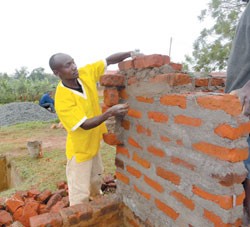Home builders in Western Kenya are leading in the use of the brick technology. It has been said to be cheaper and less of a hustle, with the bricks being made on site, writes JECKONIA OTIENO
The move towards appropriate building technologies and materials has caught steam.
From stabilised soil blocks to prefabricated building panels and even interlocking blocks such as hydrafoam, ‘innovative’ is the way to go.  |
Maurice Otieno, Mason from Yala [PHOTOS: JECKONIA OTIENO/ STANDARD]
|
It is often cheaper, the materials are locally available, and the construction can be done using unskilled labour or by labourers trained on the job.
To use or not to use bricks, is the big question.
In Western Kenya, the trends show that more property developers are opting for bricks.
This is happening across East Africa, perhaps because building stones are not in sufficient supply.
Many new buildings in the towns of Kisumu, Siaya, Kakamega and Bungoma counties are made of bricks.
A popular trend upcountry, the local technology has now hit urban centres in the region.
In Yala, for instance, many of the new buildings under construction, some of them rising to four floors, are made of bricks.
The advantage of using bricks is that they are much cheaper than soil blocks and stones.
Maurice Otieno, a builder, says that bricks are cheap and easy to work with compared to other materials.
They are also easily available in the area.
Says Otieno: "A six-by-seven brick goes for Sh7 while a nine-by-eight goes for Sh12, and this is cheaper than stone, which costs Sh26 for a nine-by-six and which we do not make around here. Building stones are mined as far away as Nakuru, but bricks are made barely a kilometre away."
Stay informed. Subscribe to our newsletter
Otieno also says using bricks has saved them transportation costs because, with the kind of soil in the region, it is easy to make bricks. In fact most people hire brick makers to make them on site. This way, they only incur the cost of labour and skill, not transport or the soil.
Environmental concerns
Most areas in western Kenya have loam soils, the right type for making bricks.
Bricks are not only cheap but also strong; even when rained on they are not destroyed as long as their initial treatment is appropriate — meaning the curing process is done right.
Ancient civilisations such as the Egyptian and Ottoman empires are said to have employed the use of brick in construction.
Aesthetics are another reason why some people would prefer bricks to stone. The red colour is warm and its earthy look creates a more homely and welcoming feel.
Houses made of brick are also warmer in cold seasons and cooler in hot seasons, as compared to those made of stone.
In Nairobi, a flunked slum upgrading programme, Mathare 4A, made full use of bricks in the construction of the housing scheme.
The making of bricks, however, has a negative impact on the environment.
The National Environmental Authority (Nema) notes that while bricks are a renewable resource, the use of firewood and the emissions produced while curing the bricks are of concern.
The Principal Wetlands Officer of Nema, Baraza Wangwe, notes that to its defence, brick making is a method of controlling surface runoff because the dug up areas act as water retention ditches.
He, however, states that in areas where runoff is not a problem, the ditches need to be planted with plants like bananas and trees.
Nema, in an effort to mitigate the loss of forests and effects of gas emissions from the combustion, is advocating for the use of modern technology in the making of bricks.
These are non-combustible bricks, which are bonded with cement and dried under a shade after being machine-pressed.
States Wangwe: "The use of firewood to cure bricks can threaten our forests; so we encourage those making bricks to consider using soil, sand and a little cement rather than relying fully on burning. This will conserve trees."
Nema also advises those making bricks in a particular area to form resource user groups because regulation is easier when the brick-makers operate in groups.
This way, it is possible to carry out environmental impact assessments.
Asked whether building with brick is likely to become a trend countrywide, Steven Oundo, the chairman of Architectural Association of Kenya (AAK), says the weight-bearing ability of bricks in high-rise buildings comes into question, adding that it will depend on the size, strength and the technique of laying the bricks.
"Columns and beams are the load transmitting elements in a building’s structure and these are usually made of concrete because of its load-bearing capacity. When using bricks, in some cases the bricks have to be laid on thick in order to support the weight from the top. For example, walls may have double thickness," he says.
Spend on cement
Oundo asserts that while stone can rise up to four floors without reinforcement on the walls, bricks can only go up to the first floor, after which reinforcement is inevitable.
In strength and durability, he says it is instructive that bricks are not inferior to other types of building blocks.
Oundo notes that most people in western Kenya are going for bricks due to their availability.
Observes Oundo: "Availability of the materials needed to make bricks has made it possible for people to use it in building, especially in Western Kenya and much of Uganda, Rwanda and Burundi."
He nonetheless points out that much as developers might spend less on sourcing the soil and on transport, they spend more on cement, which is consumed more when using bricks than when using stone.
Cement is used to stabilise the soil blocks and in the mortar that acts as an adhesive between bricks.
Oundo states that some people also don’t like the look of burnt bricks, and so end up plastering the walls just for the aesthetic value, which beats the purpose.
There are different types of bricks: Standard bricks, facing bricks, skirting bricks, hollow blocks and corner blocks.
Moses Kingo’ri, Production Manager of Clayworks Limited in Nairobi, dispels the myth that bricks are weaker than other building materials.
The strength of a brick, he says, depends on the type of clay used and on the burning process.
Contrary to popular belief, bricks are not porous.
According to King’ori, bricks are more durable than most of the stones used in building, further arguing out that most of Europe and Southern Africa is built with bricks.
 The Standard Group Plc is a
multi-media organization with investments in media platforms spanning newspaper
print operations, television, radio broadcasting, digital and online services. The
Standard Group is recognized as a leading multi-media house in Kenya with a key
influence in matters of national and international interest.
The Standard Group Plc is a
multi-media organization with investments in media platforms spanning newspaper
print operations, television, radio broadcasting, digital and online services. The
Standard Group is recognized as a leading multi-media house in Kenya with a key
influence in matters of national and international interest.
 The Standard Group Plc is a
multi-media organization with investments in media platforms spanning newspaper
print operations, television, radio broadcasting, digital and online services. The
Standard Group is recognized as a leading multi-media house in Kenya with a key
influence in matters of national and international interest.
The Standard Group Plc is a
multi-media organization with investments in media platforms spanning newspaper
print operations, television, radio broadcasting, digital and online services. The
Standard Group is recognized as a leading multi-media house in Kenya with a key
influence in matters of national and international interest.









